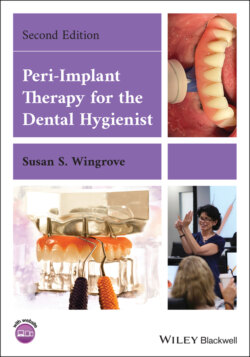Читать книгу Peri-Implant Therapy for the Dental Hygienist - Susan S. Wingrove - Страница 21
Parts and pieces for implants
ОглавлениеToday, the FDA regulates and requires data on all oral and dental implants being placed with controlled studies under medical devices to gain full approval. It is not necessary for hygienists to know all the ins and outs of implant metals and designs, since the choice of implant to use will be in the hands of the surgeon. However, the biomechanics of implants or component parts of an implant are important to know and understand. The three main component parts of an implant are the implant body, with different designs, lengths, shapes, diameters, and surfaces; secondly, the abutment, which comes in many different types and materials, and even custom abutments are available, all screw directly into the implant to connect with the restoration/prosthesis. The final stage is the prosthesis; crown, bridge, fixed prosthesis, or removable overdenture (see Figure 1.17).
Figure 1.16 Zygoma implants.
Courtesy of Nobel Biocare.
After the implant is placed into the bone, a cover screw or healing abutment (Figure 1.18) is placed directly into the implant to prevent bone and/or soft tissue from infiltrating the internal aspect of the implant during osseointegration. The healing abutment extends through the gingival tissue, forming the tissue contour/emergence profile to receive the final abutment and restoration (Figure 1.19).
At this time, well over half a million dental implants are being surgically placed annually. Implants are being properly planned and executed with success rates well over 90%. And yet, as rapidly as this field of dentistry is growing, the majority of potential dental implant patients are unaware that this treatment exists. To address this, dental hygienist can take the lead and talk with his or her patients about tooth replacement and implant dentistry. As hygienists, we need to plant the seeds with our patients that the technology exists today to better their quality of life. The knowledge of key implantology terms will allow hygienists the opportunity to talk with their patients about implants and these quality of life issues. See the Appendix for more implant dentistry terminology.
Figure 1.17 Parts and pieces.
Figure 1.18 Examples of cover screws.
Courtesy of BioHorizons.
Figure 1.19 Examples of abutments.
Courtesy of BioHorizons.
